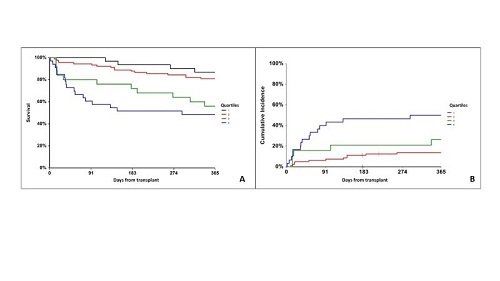
Contributions
Abstract: EP1233
Type: E-Poster Presentation
Session title: Stem cell transplantation - Clinical
Background
Recently, Endothelial Activation and Stress Index (EASIX), calculated at the onset of acute GvHD, was reported as reliable predictor of survival in patients receiving reduced intensity conditioning at transplant. We wondered if an early evaluation of the EASIX score might be able to predict survival regardless of GvHD development.
Aims
We evaluate EASIX score at day 0 in a cohort of three consecutive years patients submitted to allogeneic stem cell transplantation in our department matching data with pot-transplant outcomes.
Methods
We enrolled 179 patients consecutively submitted to allogeneic stem cell transplantation (HSCT) in our centre from January 2017 to November 2019. The most frequent diagnosis was leukemia (n=104), followed by myeloproliferative disease (n=32), myelodysplastic syndrome (n=19), lymphoma (n=22) and SAA (n=2). Median age was of 53 years (range, 14-72). Twenty patients received a mismatched donor, 72 a haploidentical donor and 87 a matched donor. Donor was unrelated in 60 patients and a relative in the others. Stem cell source was cord blood in 7 patients, bone marrow in 76 patients and peripheral blood in the other 96. Seventy-nine patients received a myeloablative conditioning and 100 a reduced intensity conditioning. EASIX score (lactate dehydrogenase U/L x creatinine mg/dl / platelets x 109/L) was calculated at day 0 before stem cell infusion (EASIX-0). No log transformation was applied.
Results
Median level of EASIX-0 was of 1.67 (95% CI 1.39-1.96) for surviving patients and 4.64 (95% CI 2.36-8.59) for patients dying after HSCT (p<0.0001). Multivariate analysis for survival confirmed EASIX-0 (HR 1.01, 95% CI 1.00-1.02, p=0.01) as predictive factor for mortality together with relapse occurrence (HR 2.92, 95% CI 1.3-4.92, p=0.0001). One-year overall survival (OS) according to EASIX-0 was as follows: <25th quartile (n=31) 86.9% (95% CI 74.9-98.9), 25th-50th quartile (n=90) 80.9% (95% CI 72.8-89.1), 50th-75th quartile (n=25) 56% (95% CI 36.2-75.5) and >75th quartile (n=33) 48.5% (95% CI 31.4-65.5) (p<0.0001, Figure 1A). Moreover, EASIX-0 was significantly associated to the cumulative incidence of transplant related mortality (TRM): HR 1.01 (95% CI 1.00-1.02) (p=0.004). Multivariate analysis confirmed EASIX-0 (HR 1.06, 95% CI 1.01-1.12, p=0.01) as predictive factor for TRM together with grade 2-4 acute GvHD occurrence (HR 8.05, 95% CI 1.92-33.80, p=0.004). One-years cumulative incidence of TRM was as follows: <25th quartile 0%, 25th-50th quartile 13.6% (95% CI 7.9-23.6), 50th-75th quartile 26.3% (95% CI 12.4-55.8) and >75th quartile 50% (95% CI 35-71.5) (p<0.0001, Figure 1B). No association was found for relapse incidence.
Figure 1. A) One-year OS survival according to Day 0 EASIX score quartiles; B) One-year TRM according to Day 0 EASIX score quartiles.

Conclusion
Early EASIX score, calculated at day 0 of transplant, appeared to be a reliable prognostic score of survival after allogeneic stem cell transplantation. We plan to enlarge the study cohort to confirm our data.
Keyword(s): HSCT, Survival prediction, Transplant-related mortality
Abstract: EP1233
Type: E-Poster Presentation
Session title: Stem cell transplantation - Clinical
Background
Recently, Endothelial Activation and Stress Index (EASIX), calculated at the onset of acute GvHD, was reported as reliable predictor of survival in patients receiving reduced intensity conditioning at transplant. We wondered if an early evaluation of the EASIX score might be able to predict survival regardless of GvHD development.
Aims
We evaluate EASIX score at day 0 in a cohort of three consecutive years patients submitted to allogeneic stem cell transplantation in our department matching data with pot-transplant outcomes.
Methods
We enrolled 179 patients consecutively submitted to allogeneic stem cell transplantation (HSCT) in our centre from January 2017 to November 2019. The most frequent diagnosis was leukemia (n=104), followed by myeloproliferative disease (n=32), myelodysplastic syndrome (n=19), lymphoma (n=22) and SAA (n=2). Median age was of 53 years (range, 14-72). Twenty patients received a mismatched donor, 72 a haploidentical donor and 87 a matched donor. Donor was unrelated in 60 patients and a relative in the others. Stem cell source was cord blood in 7 patients, bone marrow in 76 patients and peripheral blood in the other 96. Seventy-nine patients received a myeloablative conditioning and 100 a reduced intensity conditioning. EASIX score (lactate dehydrogenase U/L x creatinine mg/dl / platelets x 109/L) was calculated at day 0 before stem cell infusion (EASIX-0). No log transformation was applied.
Results
Median level of EASIX-0 was of 1.67 (95% CI 1.39-1.96) for surviving patients and 4.64 (95% CI 2.36-8.59) for patients dying after HSCT (p<0.0001). Multivariate analysis for survival confirmed EASIX-0 (HR 1.01, 95% CI 1.00-1.02, p=0.01) as predictive factor for mortality together with relapse occurrence (HR 2.92, 95% CI 1.3-4.92, p=0.0001). One-year overall survival (OS) according to EASIX-0 was as follows: <25th quartile (n=31) 86.9% (95% CI 74.9-98.9), 25th-50th quartile (n=90) 80.9% (95% CI 72.8-89.1), 50th-75th quartile (n=25) 56% (95% CI 36.2-75.5) and >75th quartile (n=33) 48.5% (95% CI 31.4-65.5) (p<0.0001, Figure 1A). Moreover, EASIX-0 was significantly associated to the cumulative incidence of transplant related mortality (TRM): HR 1.01 (95% CI 1.00-1.02) (p=0.004). Multivariate analysis confirmed EASIX-0 (HR 1.06, 95% CI 1.01-1.12, p=0.01) as predictive factor for TRM together with grade 2-4 acute GvHD occurrence (HR 8.05, 95% CI 1.92-33.80, p=0.004). One-years cumulative incidence of TRM was as follows: <25th quartile 0%, 25th-50th quartile 13.6% (95% CI 7.9-23.6), 50th-75th quartile 26.3% (95% CI 12.4-55.8) and >75th quartile 50% (95% CI 35-71.5) (p<0.0001, Figure 1B). No association was found for relapse incidence.
Figure 1. A) One-year OS survival according to Day 0 EASIX score quartiles; B) One-year TRM according to Day 0 EASIX score quartiles.

Conclusion
Early EASIX score, calculated at day 0 of transplant, appeared to be a reliable prognostic score of survival after allogeneic stem cell transplantation. We plan to enlarge the study cohort to confirm our data.
Keyword(s): HSCT, Survival prediction, Transplant-related mortality


